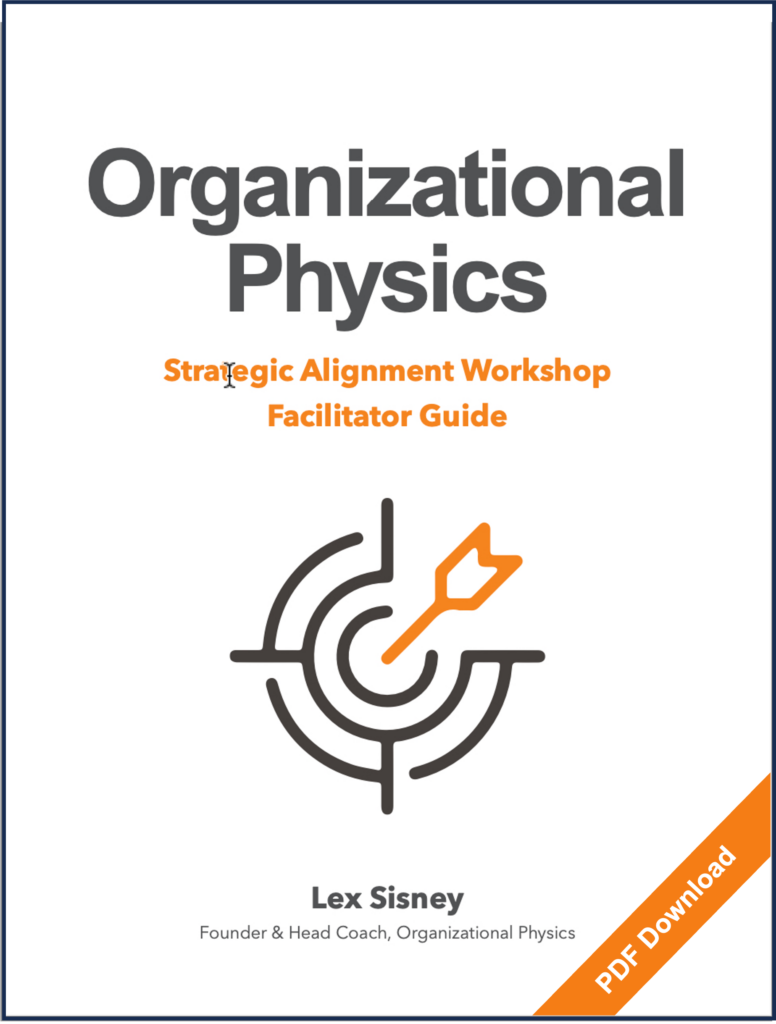Strategic alignment is the act of identifying and aligning a company’s unique and valuable capabilities with growing market opportunities. With the help of this guide and its associated SWOT analysis tools, your company can accomplish the equivalent of two to three months’ worth of strategic planning and alignment in just two days.

To achieve strategic alignment, the CEO and Leadership Team work together to identify the right three-year Top-Level Strategic Imperatives and short-term key results needed to achieve them. This top-level strategy must then be cascaded into the rest of the organization so that it can be implemented rapidly.For superior strategic alignment, this process should be conducted during an offsite strategic planning session, which lasts up to two days. Before this workshop, a new form of SWOT analysis is performed via team surveys, and participants become familiar with a framework and language for discussing strategy.
During the workshop, the results of the team surveys are used to generate shared insights and alignment on: (1) areas of improvement in the company; (2) the company’s lifecycle stage; (3) the company’s strategic execution risks; and (4) the go-forward strategic priorities.
At the end of this strategic alignment process, you will have generated a clear, concrete, and actionable roadmap for strategic execution that can be communicated to the entire company.
A key part of an effective strategic alignment process is to build shared consciousness around the company’s current strengths, weaknesses, opportunities, and threats (SWOT Analysis). However, if you have run a SWOT analysis before, you may have found that the outputs were not as useful as you would have liked. The “data” ends up being bullet points. The “insights” don’t reveal the root cause. The process itself generates a lot of opinions but it can feel harder than it should be to align the team on concrete action steps based on a traditional SWOT analysis alone.Organizational Physics has solved these shortcommings of a traditional SWOT analysis with a new, two-step SWOT analysis. The Entropy Survey is the first step which provides a root cause analysis of a company’s internal strengths and weaknesses. A company’s external opportunities and threats are then determined using the Top-level OKRs Strategy Survey.
By combining these two tools, you can produce an extremely useful SWOT analysis in a fraction of the time and with far greater insights than a traditional SWOT analysis. Some additional advantages of this new form of SWOT analysis include:
It allows for better and faster data gathering.
It provides powerful mental models for your team to visualize its strengths, weaknesses, opportunities, and threats.
It identifies the root cause of problems so that you and your team can drive continuous improvement against the right (and evolving) business strategy.
Using the Top-Level OKRs Strategy survey, the team next identifies its stage-dependent strategy, including the top-level Strategic Imperatives and annual goals. Automated reporting detects potential strategic execution risks, helping the team to avoid strategic mistakes.
– Part 1 of 2 –
Using the Top-Level OKRs Strategy survey, the team next identifies its stage-dependent strategy, including the top-level Strategic Imperatives and annual goals. Automated reporting detects potential strategic execution risks, helping the team to avoid strategic mistakes.
Here’s a class I taught on how to run a kick-ass strategic alignment workshop using these tools and the following guide. The video will provide you with the big picture, then you can dive into the step-by-step guide below.
Two people in your company should read the following guide:
The CEO should not also be the Facilitator. The Facilitator and the CEO are two distinct roles that should be played by two people. Note that the Facilitator may or may not be a part of the Leadership Team. The CEO should read this guide to become familiar with the overall process. The Facilitator should read this guide and then actually use it as a roadmap and checklist to run a successful Strategic Alignment Workshop for the CEO and Leadership Team.
The workshop participants should be the CEO and the Leadership Team. If there are other key high-level influencers in the company, the CEO should consider whether they should be present as well. Each core function in the company should be represented by one participant.The number of participants is usually 12 to 15. The basic idea behind this mix of participants is simple. If this cross-functional group of leaders goes through a well-designed process together, they can more easily recognize and agree on the best course of action for the whole company. Additionally, because of their shared participation and insights, they can also now articulate to their teams why that course of action is the right one. In essence, when the heads are clear and committed, the rest of the organizational body will follow.
I recommend holding this workshop in person at an off-site location away from the regular office environment. However, if you need to facilitate a virtual workshop, you can replicate my instructions for a virtual setting.


This is a guide, not a book, so you should use it as one. You should view this guide as your roadmap for preparing for the workshop and for ensuring proper follow up afterward. Print it out. Make sure you follow the steps in order. Check them off as you go.
The first steps include arranging workshop logistics and meeting with the CEO to align on the workshop objectives and process. Here are your key tasks at this stage:
To prepare a given tool, log into your Organizational Physics Members Area. At the top, click on the appropriate tab (for example, “Entropy Survey”), and then click on “Add New Survey.” Follow the steps from there.

Send the Homework Assignments. Attendees receive their homework assignments from you via email. Space out the assignments so that attendees can complete one or two items per week. Stress the importance of getting high-quality input from the team. Make the final deadline 72 hours before the workshop starts so that you and the CEO have time to read the results and prepare for the workshop.
To close a given survey and read the report, log into your Organizational Physics Members Area, click on the appropriate tool tab (for example, “Entropy Survey”), change the survey status to “Closed,” then click “View” to view, and download the report.


A detailed workshop schedule and room set up requirements can be accessed in the Workshop Schedule and Room Setup Requirements document.
Congratulations! Your job as Facilitator is done. It is now up to the CEO and the Leadership Team to communicate the results of this process with the rest of the company and drive the strategy forward.



Let’s build your high-performance organization together.
Organizational Physics® empowers CEOs and leadership teams to scale with clarity and confidence. By applying universal principles and proven frameworks, we help organizations improve internal performance, accelerate growth, and build resilient structures for the long term.
© Copyright Organizational Physics Inc.